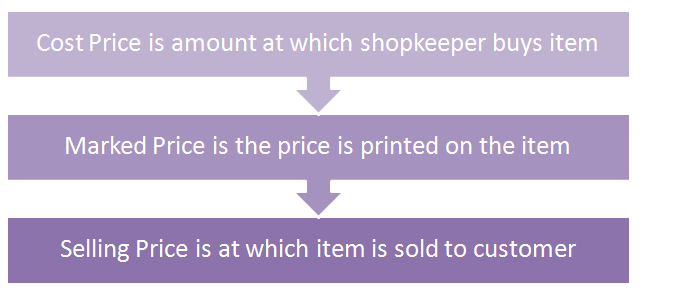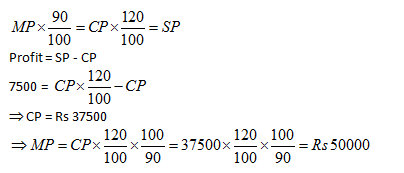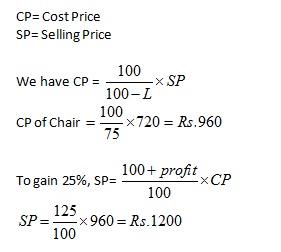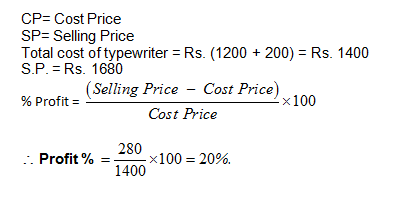How To Find Marked Price
True cat 2022 Profit and Loss: Concept of Discounts and Marked Toll Explained
In the first role of Profit and Loss series, we learnt the basic definitions and the pregnant of Cost Toll, Selling Price, Marked price etc. Permit us revise the definition of Marked Price. As we saw before, traders are in the habit of marker their articles at a certain cost higher up their costs. Then the discounts they offer are on this marked price, thereby they actually brand certain that have already factored in the profit they desire.

Discounts are offered on the marked price and the selling cost is determined by the discount offered on the marked cost. For the process of simplification, let us assume:
C = Cost price
S = Selling cost
M = Marketplace toll
D% = Discount
G% = Proceeds
Now,
Discount = D% of marked toll, M
Discount = Marked Price – Selling Toll
Marked Toll – Amount of Discount = Selling Price
1000 (1-D%) = Selling Toll
Also, Selling Price = Cost Cost + Gain
Thus,
M (1-D%) = C (i + Chiliad%)
Or in other words
Marked Price (1 – Disbelieve%) = Cost Price (one + Gain%)
Example-1: Natasha offers her customers a discount of 10% on her beauty products and she still makes a profit of twenty%. What is the actual price to her of that beauty product marked Rs. 400?
Solution:
Marked price = Rs. 400
Disbelieve = 10%
Profit = twenty%
Therefore, the Selling Price = 90% of 400
Therefore 400 x 90/100 = Rs. 360
Selling price = Rs. 360
Profit = 20%
Cost price = 100/120 x 360 = Rs. 300
CAT 2022 Profit and Loss: Concept of successive discounts
If successive discounts of ten% and y% are immune on the marked cost M of the discount, then, afterwards discount the client finally ends upward paying:
Selling Toll = (i-x%)(1-y%) x Marked Price
If you look at the above formula closely, you would see that the multiplication is nothing else merely a percentage equivalent of two successive percentage change on a number.
Example-two: Pankaj offers a ten% discounts on his appurtenances and he offers a further discount of 5% on the reduced toll to those customers who pay cash. What does a customer accept to pay in greenbacks for a cricket bat of Rs. 200?
Solution:
Price of the cricket bat = Rs. 200
After Disbelieve of 10% Marked price would exist Rs. 180
Since he is purchasing the bat by greenbacks, so a discount of five% is applicable again on the reduced marked price. Thus, the concluding selling toll the cricket bat would be of Rs. 171
True cat 2022 Turn a profit and Loss: Basic Question types
Type-1: Comparison quantities of goods and prices
In these types of questions, CP of a fixed number of goods are compared with the SP of another field number of appurtenances. Permit us meet through an example:
Example-3: The price price of 30 articles is equal to the selling toll of 40 articles. What is the profit or loss pct?
Solution:
To obtain the same amount of money, which was needed to purchase xxx manufactures, nosotros demand to sell 40 articles, which is more than than what we have got for the same sum. It means nosotros need to arrange 10 more articles apart from the articles which we take purchased. So, there will exist a loss.
Now, CP of 30 articles = SP of xl articles Or, CP/SP = 30/40 =3/iv
Or, ane – CP/SP = 1- 3/4 = 1/4
So, Loss percentage
= (l – CP/SP) x 100 = one/4x 100 = 25%
Alternatively,
CP of 30 articles = SP of twoscore manufactures = Rs 120 (Presume) And then, CP of ane article = Rs four ,SP of one commodity = Rs three Manifestly, at that place is a loss of Re 1 Loss percentage = 1,iv X 100 = 25%
Type 2: Questions in terms of money
In this type of question, nosotros generally talk about the cost price and selling toll questions at that place are some results which helps united states of america to solve typical these blazon of questions
Some Of import Results
When SPs of two articles are same
ane. Beginning one is sold at a turn a profit of ten% and 2nd one is sold at a profit of y%.
Ratio of CP1:CP2 (100 + y) : (100 + ten)
2. First one is sold at a profit of ten% and 2d ane is sold at a loss of y%.
Ratio of CP1:CP2 = (100 – y): (100 + x)
3. Showtime i is sold at a loss of ten% and second one is sold at a loss of y%.
Ratio of CP1: CP2 = (100 – y): (100 – x)
4. Outset one is sold at a loss of x% and second one is sold at a profit of y%.
Ratio of CP1: CP2 = (100 + y): (100 – x)
Type-iii: Miscellaneous Problems based on % gain and % loss
Example-iv: Bharat purchased 90 bags of cement at Rs. 450 each. He sold thirty bags at 20% profit and 20 bags at vi% loss. At what rate per bag should the remainder he sold to gain a profit of 9% on whole transaction
Solution:
This question type is nothing else but a combination of ratio and proportion with profit and loss. In this case, we can solve the question in the following manner:
According to the information given, numberless remaining = 40
Let the 40 bags exist sold with p% proceeds
Now % gain or loss on the whole lot
= sum of product of proceeds or loss %southward with their respective quantities
Therefore
9% of 90 Numberless of Rs. 450 each = 20% of 30 Bags of Rs. 450 each – vi% of 20 Bags of Rs. 450 each +9% of 40 Numberless of Rs. 450 each
(nine/100) x 90 x 450= {(xx/100) 10 30 ten 450} – {(6/100) 10 twenty 10 450} + {(p/100) 10 40 10 450}
nine x 90 = (xx x 30) – (half dozen x twenty) + (p ten 40)
p = eight.25%
Therefore, the selling price would be = 108.25/100 x 450 = Rs. 487.125
CAT 2022 Profit and Loss: Discounts and Marked Price Do Exercise
Question 1:
A shopkeeper offers twenty% discount and notwithstanding makes profit of 25%. Calculate the cost of article which has a marked price of Rs 200.
a. Rs. 130
b. Rs. 128
c. Rs. 125
d. Rs. 140
Respond and Explanation
Selection b
Utilize formula
Marked cost (1-disbelieve%)= Cost price (1+turn a profit%)
200(1-0.2)= Cost price (1+0.25)
Cost Price = (200 x 0.eight)/1.25 = Rs. 128
Question 2:
A merchant fixes the sale price of his appurtenances at fifteen% above the cost price. He sells his goods at 12% less than the fixed price. His percentage of profit is :
(a) 2.5%
(b) i.two%
(c) 1.v%
(d) ii%
Answer and Explanation
Option b
Let the toll price be Rs. 100.
Marked price = Rs. (100 + 15% of 100) = Rs. 115
The goods are sold at the disbelieve of 12%.
S.P. = (115 – 12% of 115)
= Rs. (115 – 13.80) = Rs. 101.20
Profit = Rs. (101.20 – 100) = Rs. one.xx
Question 3:
A dealer makes a profit of 20% even afterward giving a 10% disbelieve on the advertised toll of a scooter. If he makes a profit of Rs. 7500 on the sale of the scooter, the advertised cost was
(a) Rs. 45000
(b) Rs. 47500
(c) Rs. 50000
(d) Rs. 52500
Respond and Caption
Option c
The advertizement cost is basically the marked price.
The dealer makes a profit of xx% after giving a 10% discount, so
marked price (1-disbelieve%)=cp(i+profit%)

Question iv:
If a human being were to sell his chair for Rs. 720, he would lose 25%. To gain 25% he should sell it for
(a) Rs. ane,200
(b) Rs. 1,000
(c) Rs. 960
(d) Rs. 900
Answer and Explanation
Choice a

Question 5:
A man bought an erstwhile typewriter for Rs. 1200 and spent Rs. 200 on its repair. He sold it for Rs. 1680. His turn a profit per cent is:
(a) twenty%
(b) 10%
(c) 8%
(d) 16%
Answer and Caption
Option a

Table of Contents: Profit and Loss Complete Lesson
Source: https://wordpandit.com/profit-and-loss-discounts-marked-price/
Posted by: benoithoughle.blogspot.com


0 Response to "How To Find Marked Price"
Post a Comment